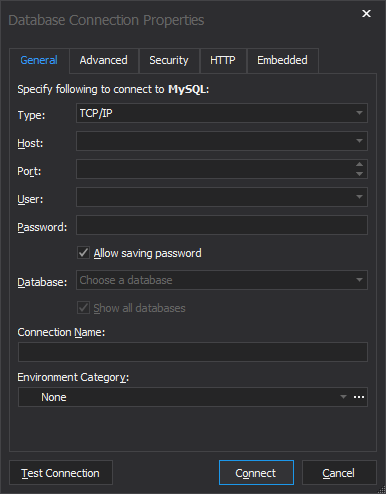Connecting to a Database
dbForge Data Generator for MySQL offers you visual, quick, and simple way to manage database connections through the Connection Manager window.
Create a New Server Connection
Before you can connect to a database, you must create a server connection.
To create a server connection, perform the following actions:
-
Open the Database Connection Properties dialog box by either clicking New Connection on the Database menu or by clicking the New Connection button on the Connection toolbar.

-
Select the connection type in the Type box. There are tow connection types available: TC/IP and Named pipe.
-
Enter the host name in the Host box.
-
For a TC/IP connection, enter the port information in the Port box. Default port number is 3306. For a Named pipe connection, enter the pipe name in the Pipe box.
-
Enter the login credentials in the User and Password fields.
-
In Database, type or select the name of the database to which you want to connect.
-
The Connection Name should be generated automatically from the Host name. You can create a distinctive name for your new connection.
-
(optional) You can assign a category for a new connection in the Document Category box.
-
(optional) You can click Advanced to configure advanced connection properties.
-
(optional) You can click Security to configure security properties. For example, you can set up either SSL or SSH security properties.
-
(optional) You can click HTTP to configure HTTP tunnel properties.
-
(optional) You can click Test Connection to verify that you can connect to the database by using the specified connection information.
-
Click OK to create the connection.
The Connection toolbar is hidden by default. To unhide it, right-click the Menu bar and choose Connection.